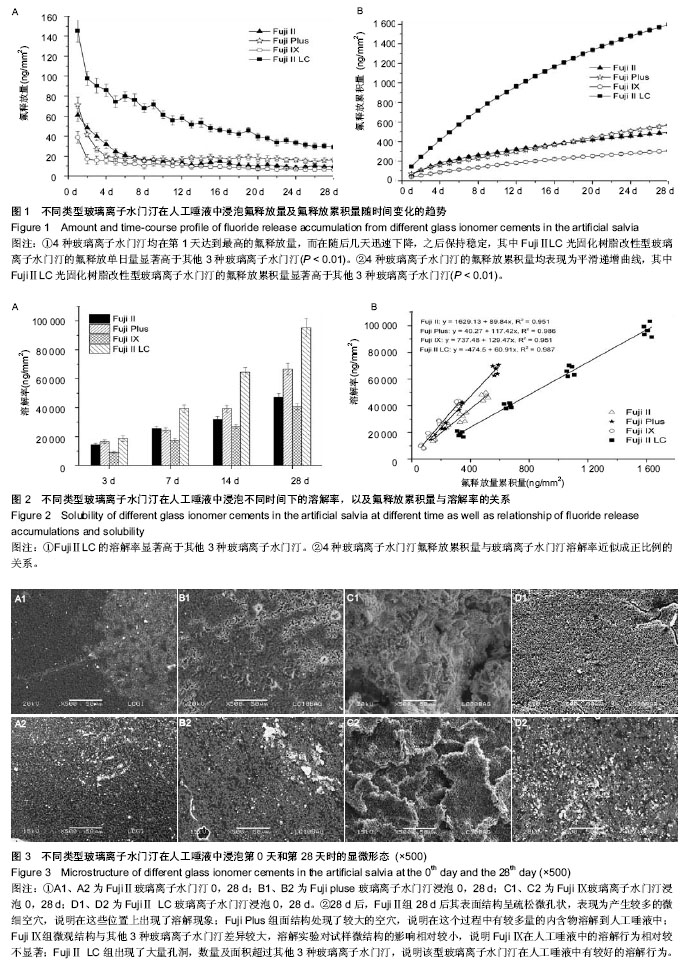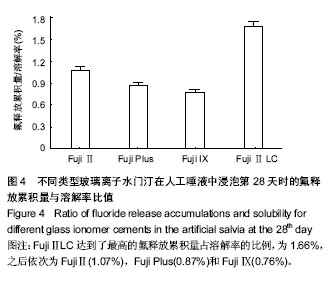| [1] 王瑾,程为庄.玻璃离子水门汀的研究进展[J].北京生物医学工程,
2005,24(2):139-143.
[2] Leinfelder KF. Glass Ionomer: current clinical development. J Am Dent Assoc. 1993;124(9):62-64.
[3] Forsten L.Resin-modified glass-ionomer cements fluoride release and uptake. Acta Odonto Scand.1995;53:222-225.
[4] Wilson AD,Kent BE.The glass-ionomer cement. A new translucent dental filling material.Appl Chem Biotechnol.1971;21:313-320.
[5] Smith DC.Glass ionomer cements:a prospect, In:Proceedings of the Symposium on Aesthetic Restorative Materials.J Am Dent Assoc.1993:49-59.
[6] Zhang L,Wang X,Liu HY.Bond strength between titanium alloy with different surface roughness and dentin.J Clin Rehab.2009; 13(49):9398-9400.
[7] Balamungan A,Baiossier G,Lanrent-Maquifi D,et al.An in vitro biological and antibacterial study oll a sollel derived silver-incerporated biogless system. Dent Mater. 2008;24(10): 1343-1351.
[8] Lucas ME,Arita K,Nishino M.Strengthening a conventional glass ionomer cement using hydroxyapatit.J Dent Res.2001;80 (special issue):711.
[9] Lohbauera U,Walker J,Nikolaenko S,et al.Reactive fibre reinforced glass ionomer ecements.Biomaterials. 2003;24(17): 2901-2907.
[10] 崔恺,陈吉华,赵三军.玻璃离子水门汀的研究进展[J].牙体牙髓牙周病学杂志. 2008,18(11):644-647.
[11] Arita K,Lucas ME,Nishino M.The effect of adding hydroxyapatite on the flexural strength of glass ionomer cement.Dent Mater. 2003; 22(2):126-136.
[12] Lucas ME,Arita K,Nishino M.Flexural strength of hydroxyapatite- added glass ionomer cement.J Dent Res. 2002; 81(Special issue A):36.
[13] Gu YW,Yap AUJ,Cheang P,et al.Zirconia-glass ionomer cement potential substitute for Mieade Mix.Biomaterials. 2004;52(2): 113-116.
[14] Smith DC.Glass ionomer cements.In: Kawahra H, editor, Proceedings of the International Congress on Implant Bio-mater in Stomata.Tokyo: Ishiyaku, 1980:26-54.
[15] Smith DC.A review of the zinc polycarboxylate cements.J Can Dent Ass. 1971;37:22-30.
[16] Wilson AD,Crisp S,Abel G.Characterization of glass-ionomer cements: Effect of molecular weight on physical properties.J Dent.1977;5:117-120.
[17] Prosser HJ,Powis DR,Wilson AD.Glass-ionomer cements of improved flexural strength.J Dent Res.1986;65:146-148.
[18] Nakajima N,Watkins JH,Arita K,et al. Mechanical properties of glass ionomers under static and dynamic loading.Dent Mater. 1996;12:30-37.
[19] Helena YU,Liptxo VJLT,Timo N,et al.Compressive strength and surface characterization of glas ionomer cements modified by particle of bioactive glass. Dent Mater.2005;21(3):201-209.
[20] Yli-Urpo H,Vallittu PK, Närhi TO,et al.Release of silica, calcium, phosphorus and fluoride fromglass ionomer cernent containing bioactive glass.J Biomater Appl.2004;19(1):5-20.
[21] Nychka JA,Li D,Alexander B.In vitro bioactivity of 45S5 bioactive glass as a function of indentation load.J Mech Behav Biomed Mater.2008;1(3):243-251.
[22] Marending M,Stark WJ,Brunner TJ,et al.Comparative assessment of time-related bioactive glass and calcium hydroxide effects on mechanical properties of human root dentin. Dent Traumatol.2009;25(1):126-129.
[23] Choi JY,Lee HH,Kim HW.Bioactive sol-gel glass added ionomer cement for the regeneration of tooth structure.J Mater Sci Mater Med.2008;19(10):3287-3294.
[24] Xie D,Zhao J,Weng Y,et al.Bioactive glass-ionomer cement with potential therapeutic function to dentip capping mineralization.J Oral Sci.2008;116(5):479-487.
[25] Zehnder M,Sôdealing E,Sahnen J,et al. Preliminary evaluation of bioactive glass S53P4 as an endedontic medication in vitro. J Endod.2004;30(4);220-224.
[26] Lohbauera U,Walker J,Nikolaenko S,et al.Reactive fibre reinforced glass ionomer ecements. Biomaterials. 2003;24(17): 2901-2907.
[27] Masayuki KAGA,Masahiro K,Kosuke I,et al.Cytotoxicity of Strengthened Glass-ionomer Cement by Compounding Short Fibers with CaO-P2O5-SiO2-Al2O3 Glass. Nano Biomed. 2010;2(1):23-30.
[28] MeCabe JF. Resin-modified glass-ionomers. Biomaterials. 1998; 19(6):521-527.
[29] 曹院琴,李永祥.3种玻璃离子水门汀氟释放能力的体外研究[J].中华老年口腔医学杂志, 2013,11(2):116-118.
[30] Mousavinasab MS,Meyers I.Fluoride release and uptake by glass ionomer cements. compomers and giomers.Res J Biol Sci.2009;4(5):609- 616.
[31] Chan WD,Yang L,Wang W,et al. Fluoride release from dental cements and composites: a mechanistic study.Dent Mater. 2006;22(4):366- 373.
[32] Verbeeck RM,deMoor RJ,Van Even DF,et al.The short-term fluoride release of a hand - mixed vs. cap sulated system of a restorative glass - ionomer cement. J Dent Res. 1993;72: 577-581.
[33] Musa A,Pearson GL,Gelbier M.In vitro investigation of fluoride ion release from four resin - modified glass polyalkenoate cements. Biomaterials.1996;17(10): 1019-1023.
[34] 张军,彭彬.不同类型玻璃离子水门汀氟离子体外释放的比较[J].牙体牙髓牙周病学杂志,2008,18(1):28-30.
[35] Williams JA,Billington RW,Pearson GJ. A long term study of fluoride release from metal - containing conventional and resin- modified glass-ionomer cements. J Oral Rehabil. 2001;28(1): 41-47.
[36] 赵守亮,宋江红,王景杰,等.玻璃离子水门汀加入银合金粉后对其抗压强度和表面硬度的影响[J].牙体牙髓牙周病学杂志, 1997,7(4): 246-247.
[37] Moreau JL,Xu HH.Fluoride releasing restorative materials: Effects of pH on mechanical properties and ion release.Dent Mater.2010;26(11):e227-e235.
[38] Kuhn AT,Wilson AD.The dissolution mechanisms of silicate and glass-ionomer dental cements.Biomaterials.1985;6(6):378-382.
[39] 厚继续,张彩霞,陈德敏,等.玻璃离子水门汀释放氟实验研究[J].口腔材料器械杂志,2002,11(4):175-183.
[40] 韩宁宁,莫三心.不同pH 值的浸泡液对玻璃离子水门汀溶解性的影响[J].口腔材料器械杂志,2007,16(1):15-17.
[41] 吴玮,陈吉华,赵三军.3种水门汀早期溶解性比较研究[J].口腔医学研究,2007,23(2):194-196.
[42] Tllrklln LS,Turkan M,Ertugrul,et al.Long-term antibacterial effects and physical properties of a chlorhexidine-containing glass ionomer cement. J Esthet Restor Dent.2008;20(1):29-45.
[43] Kawano F,Kon M,Kobayashi M,et al.Reinforcement effect of short glass fibers with CaO-P2O5-SiO2-Al2O3 Glass on strength of glass ionomer elements.J Dent. 2001;29(5):377-380.
[44] 程汉亭,刘韩星,肖群.玻璃离子水门汀短期力学性能的研究[J].生物医学工程研究, 2005,24(1):55-57.
[45] Zimehl R,Hannig M.Non metaIlic restorative materials based on glass ionomer cements-recent trends and developments. Colloids and Surfaces.2000;63:55-55.
[46] 张海英,侯本祥,陈薇.四种玻璃离子充填材料释氟性与溶解性的研究[J].北京口腔医学, 2011,19(5):260-262.
[47] 崔恺,陈吉华,赵三军.不同剂型玻璃离子水门汀溶解性比较研究[J].牙体牙髓牙周病学杂志,2008,18(2):87-89. |



.jpg)